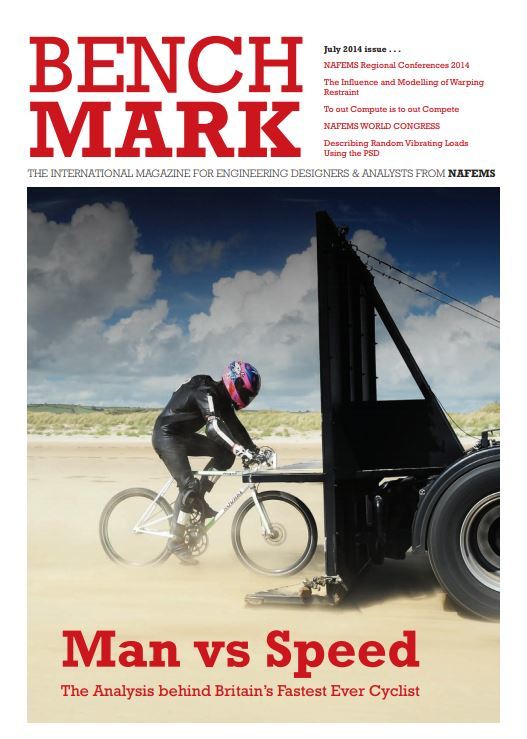BENCHMARK July 2014
Man vs Speed - The Analysis behind Britain's Fastest Ever Cyclist

In this Issue...
- NAFEMS Regional Conferences 2014
- The Influence and Modelling of Warping Restraint
- To out Compute is to out Compete
- NAFEMS WORLD CONGRESS
- Describing Using the PSD
Well, wasn’t that a busy few months....
Since our last issue in April, we’ve just completed our largest and most successful Regional Conference programme yet. Five event sheld around the world, welcoming more than 1,000 individuals to engage with the engineering analysis community, share their experiences, and network with peers. The presentations given at each event were of outstanding quality,giving all attendees a unique insight into the analysis processes and projects being carried out by their colleagues (and competitors!) day to day. In addition, workshops, discussion sessions and training courses came together to make an outstanding series of events which will have provided a great experience for all those present. A summary of some of the key themes can be found on page 6 of this issue. In true NAFEMS fashion, we never stand still. The call for papers for next year’s NAFEMS World Congress is well and truly open, with abstracts already coming in for the event which will take place in San Diego next June.
As ever, we’re planning on making the 2015 Nafems World Congress the biggest and best yet, bringing the analysis community together for a unique independent global conference which is unmatched anywhere in the engineering analysis world. This really is an opportunity to get involved, and I would encourage you to take a look at the Congress website at www.nafems.org/congress and consider submitting an abstract. This issue showcases a number of excellent technical articles, as well as some interesting applications of the technology. Our summary of the CFD involved in helping to break cycling-speed records comes off the back of a presentation of the subject at our UK Conference, and provides a real insight into how computational fluid dynamics really can help to gain those extra vital seconds in record attempts such as this. The subject of High Performance Computing is tackled head on, as we propose that to ‘out-compute’ is to ‘outcompete’– increased computing power really can lead to a significant competitive advantage. In his issue, we also attempt to strip some of the “mathematical mysticism” from the Power Spectral Density (PSD) function in relation to random loads, and describe the function in a more intuitive fashion, whilst another article looks at the influence of warping on structural steel beams.
As always, benchmark is produced entirely for you, the simulation community, and we welcome feedback, good or bad, on the articles contained, or the type of articles you want to see. Indeed, we’re always open to submissions, so if you have something you want to share with the community, get in touch.




